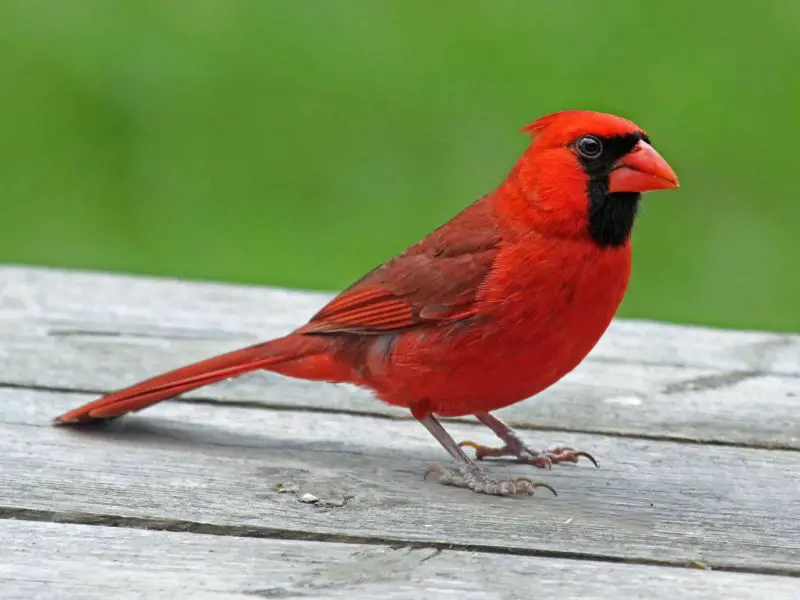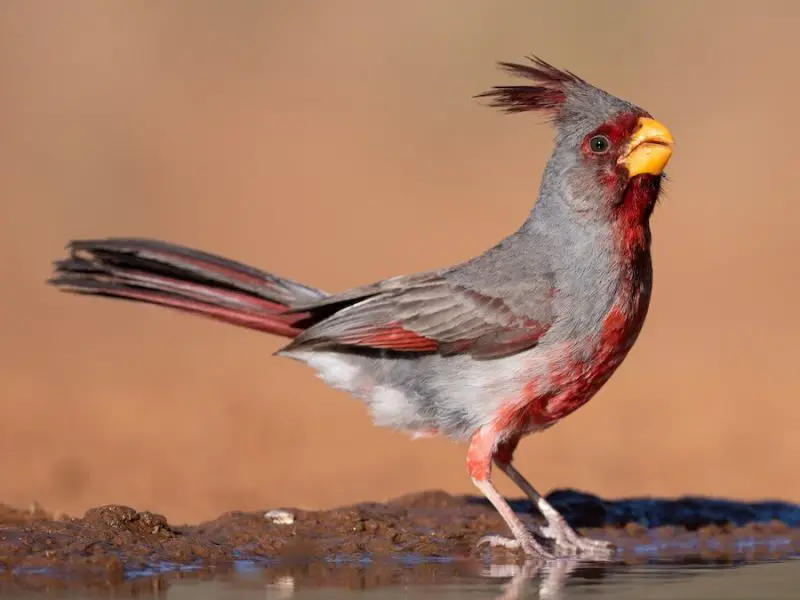Beloved for their beauty and song, cardinals are iconic birds in North America, with Ohio providing an ideal setting for birdwatchers to enjoy them. Known for their bright plumage, distinctive songs, and year-round presence, these birds bring a touch of beauty to both urban and rural landscapes. If you spend time outdoors in Ohio, you will most likely encounter cardinals, especially near wooded edges, gardens, or parks.
Although many people only think of the famous Northern Cardinal when talking about cardinals in Ohio, there are actually two types of cardinals that birdwatchers should know about. Each has its own unique features, behavior, and preferred habitats, making them fascinating species to study and identify. By learning more about them, you can sharpen your birdwatching skills and better appreciate Ohio’s natural biodiversity.
This article provides a detailed guide to the two types of cardinals in Ohio, complete with identification tips, habitat descriptions, comparisons, and the best times and places to observe them.
Northern Cardinal (Cardinalis cardinalis)

Characteristics and Appearance
The Northern Cardinal is the most iconic cardinal in Ohio and perhaps the most recognizable bird across the United States. Males are especially striking with their vibrant red feathers, a black mask around the face, and a prominent crest atop the head. Females, although more subdued in coloration, display beautiful warm tones of tan, buff, and orange with subtle red highlights on the wings and tail. Both sexes share the distinctive cone-shaped orange bill, which is excellent for cracking seeds.
Their body length ranges between 8.3 to 9 inches, with a wingspan of about 10 to 12 inches. The male’s bright red plumage makes him especially noticeable during winter months when he contrasts against snowy backdrops. The female’s muted colors, however, provide effective camouflage while nesting.
Behavior and Feeding Habits
Northern Cardinals are non-migratory birds, meaning they can be observed year-round in Ohio. They are highly territorial, particularly during the breeding season, when males defend their chosen area through song and display. Their melodic whistles, often described as “cheer, cheer, cheer” or “birdie, birdie, birdie,” are commonly heard in Ohio gardens and woodlands.
These cardinals primarily feed on seeds, fruits, and insects. In urban and suburban areas, they frequently visit backyard feeders, especially those stocked with sunflower seeds, safflower seeds, and cracked corn. During breeding season, insects form an important part of their diet, providing the protein needed for young chicks.
Habitat in Ohio
Northern Cardinals thrive in a wide variety of habitats, making them one of the most adaptable bird species in the state. They are commonly found in woodlands, forest edges, thickets, farmlands, and suburban yards. Because they prefer dense vegetation for nesting, areas with shrubs, hedges, and understory growth provide ideal conditions.
In Ohio, they are especially abundant in central and southern regions, although their presence is widespread throughout the entire state. They build cup-shaped nests in low shrubs or trees, using twigs, grass, and leaves as construction materials.
Breeding and Nesting
Breeding season for Northern Cardinals in Ohio usually begins in late March and can extend into late August. Females typically lay 2 to 5 eggs, which hatch after about 12 days. Both parents share the responsibility of feeding the chicks, although the female is more involved in incubation. Remarkably, cardinals often raise two or even three broods per season, ensuring a strong population.
Their loyalty to mates is another fascinating trait, as many pairs remain together year after year. During courtship, the male often feeds seeds directly to the female, a touching behavior that strengthens their bond.
Identification Tips
When observing Northern Cardinals in Ohio, the key identification features include the male’s bold red coloration, the black mask around the face, and the sharp crest. Females, while less colorful, can be recognized by their warm buff tones, reddish highlights, and the same conical bill. Both sexes are larger than sparrows and more robust than finches, making them fairly easy to distinguish.
Pyrrhuloxia (Cardinalis sinuatus)

Characteristics and Appearance
Although not as common in Ohio as the Northern Cardinal, the Pyrrhuloxia is another fascinating member of the cardinal family that occasionally appears in the state. Sometimes called the “desert cardinal,” this species is typically native to the southwestern United States. However, rare sightings in Ohio have sparked excitement among birdwatchers and ornithologists.
The Pyrrhuloxia resembles the Northern Cardinal in size, measuring around 8 inches in length, but its coloration sets it apart. Instead of the all-over red of the Northern Cardinal, Pyrrhuloxias have grayish bodies with crimson accents on the crest, wings, tail, and face. Their bills are distinctively short, stubby, and yellowish, adapted for cracking tough seeds.
Behavior and Feeding Habits
Pyrrhuloxias share many behavioral traits with their northern cousins, including territorial singing and seed-based diets. However, they are often more tolerant of dry and arid conditions. Their songs are slightly different, usually more metallic and less melodic than the Northern Cardinal’s calls.
In terms of feeding, they rely on seeds, berries, and insects. Their unique bill shape gives them an advantage when handling particularly hard seeds that might be difficult for other songbirds to crack open.
Habitat in Ohio
While the Pyrrhuloxia is not a resident species in Ohio, occasional vagrants may be observed during unusual weather patterns or migration-related wanderings. They are more commonly associated with the deserts of Arizona, New Mexico, and Texas, but birdwatchers in Ohio remain hopeful of spotting these rare visitors, especially in southern parts of the state.
When they do appear, they are often found near open fields, brushy areas, or places with scattered shrubs where they can forage and seek cover. Because of their rarity, spotting one in Ohio is considered a memorable birding event.
Breeding and Nesting
Unlike the Northern Cardinal, Pyrrhuloxias do not typically breed in Ohio. Their breeding range is limited to the southwestern United States and northern Mexico, where they build nests in thorny shrubs or cacti. However, understanding their breeding behavior provides useful context for identification. Females usually lay 2 to 4 eggs per clutch, with incubation lasting about two weeks.
If a Pyrrhuloxia pair were ever to attempt breeding in Ohio, it would be an extraordinary record for ornithologists. While unlikely, the possibility adds intrigue to the rare sightings.
Identification Tips
To distinguish a Pyrrhuloxia from a Northern Cardinal in Ohio, look closely at the coloration and bill shape. Pyrrhuloxias appear predominantly gray with red highlights, unlike the full-bodied red of the Northern Cardinal. Their shorter, curved bill is another reliable field mark. If you hear a song that resembles the Northern Cardinal but seems sharper or more metallic, it may hint at this unusual visitor.
Comparing the Two Cardinals in Ohio
Although both species belong to the same cardinal family, the Northern Cardinal and Pyrrhuloxia differ significantly in appearance, range, and frequency in Ohio. The Northern Cardinal is the state’s most abundant cardinal and a permanent resident, easily recognized by its all-red male plumage and widespread presence in suburban and rural areas.
The Pyrrhuloxia, in contrast, is a rare visitor to Ohio, with its grayish body and crimson accents distinguishing it from the bright Northern Cardinal. While Northern Cardinals breed prolifically in Ohio, Pyrrhuloxias typically breed only in the arid southwest. Behaviorally, both are seed-eaters with strong territorial instincts, but their songs vary slightly, with Pyrrhuloxias producing sharper notes.
For birdwatchers in Ohio, this comparison highlights why spotting a Pyrrhuloxia is such a remarkable event. Observing both types offers a deeper appreciation of the diversity within the cardinal family.
Best Time and Places to Observe Cardinals in Ohio
Cardinals can be observed year-round in Ohio, with Northern Cardinals being the most reliable sighting. Winter provides particularly beautiful opportunities as their red plumage contrasts against snowy landscapes. Early morning and late afternoon are the best times to hear their melodic songs and watch them actively foraging.
The best places to see Northern Cardinals in Ohio include state parks, forest edges, suburban neighborhoods, and backyard feeders. Providing sunflower seeds, safflower seeds, and dense shrubs will almost guarantee their presence. For those hoping to spot the rarer Pyrrhuloxia, southern Ohio regions may offer the greatest chance, especially during unusual migration years.
Birdwatchers who keep detailed records and report rare sightings contribute significantly to ornithological knowledge. Local birding groups and organizations such as the Ohio Ornithological Society often track such reports, making them a great resource for enthusiasts.
FAQs about Cardinals in Ohio
Are Northern Cardinals common in Ohio?
Yes, Northern Cardinals are extremely common in Ohio and can be found year-round across the state.
Can Pyrrhuloxias really be seen in Ohio?
While very rare, there have been occasional sightings of Pyrrhuloxias in Ohio, usually as wandering vagrants from the southwest.
What do cardinals eat in Ohio?
Cardinals primarily eat seeds, fruits, and insects. In backyards, they are attracted to sunflower and safflower seeds.
When is the best time to see cardinals in Ohio?
Cardinals are visible throughout the year, but winter offers particularly striking views due to their bright plumage against snow.
How can I attract cardinals to my backyard?
Providing feeders with sunflower seeds, planting dense shrubs for nesting, and ensuring a reliable water source are effective ways to attract cardinals.
Conclusion
Ohio provides birdwatchers with excellent opportunities to observe cardinals, particularly the brilliant Northern Cardinal, which is abundant across the state. The rarer Pyrrhuloxia adds a touch of excitement to birding, as spotting one is considered a notable event. By learning to identify their features, understanding their habitats, and knowing when and where to look, you can fully enjoy the beauty these birds bring to Ohio’s landscapes.
For both casual observers and dedicated birders, cardinals remain a source of inspiration and delight. Their year-round presence, vibrant colors, and enchanting songs ensure that they hold a special place in Ohio’s natural heritage.






